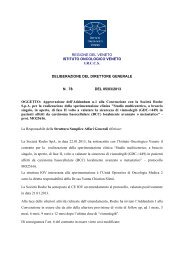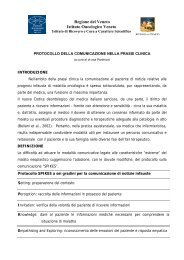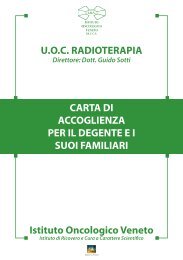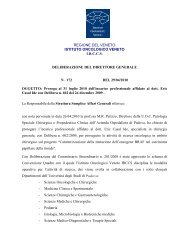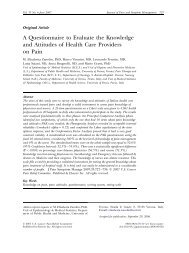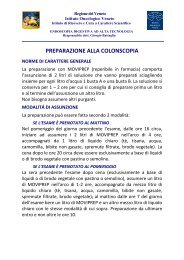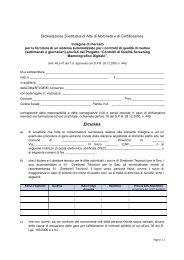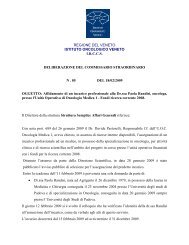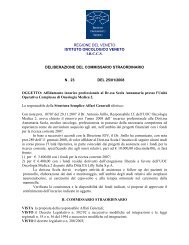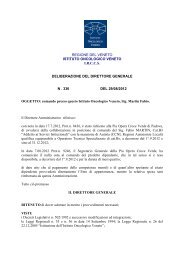SCIENTIFIC REPORT 2010 - 2011 - IOV
SCIENTIFIC REPORT 2010 - 2011 - IOV
SCIENTIFIC REPORT 2010 - 2011 - IOV
You also want an ePaper? Increase the reach of your titles
YUMPU automatically turns print PDFs into web optimized ePapers that Google loves.
Unit. The Unit mission includes collaborative efforts with other<br />
regional hospitals to set up clinical genetic counseling facilities<br />
according to national and international guidelines for the genetic<br />
tests in hereditary breast and ovarian cancer patients. During the<br />
last three years, 577 new breast and ovarian cancer families were<br />
recruited and screened. A total of 760 BRCA1 and BRCA2 tests<br />
were performed using highly comprehensive mutation detection<br />
strategies that cover the entire BRCA1 and BRCA2 mutational<br />
spectra, including major genomic rearrangements. Mutationspecific<br />
tests were offered to eligible relatives of the positive cases,<br />
allowing for the identification of at risk family members who were<br />
counseled and clinically managed according to the result of the<br />
specific test. To date, the number of BRCA1/2 mutation positive<br />
families identified by the Unit from the start of its activity has<br />
raised to 253 for a total of more than 450 carriers of deleterious<br />
mutations.<br />
Results and conclusions. The understanding of the genetic<br />
determinants of the non-informative families is one of the key<br />
goals of our most recent studies. Evaluation of the clinical relevance<br />
of BRCA1 and BRCA2 sequence variants of unknown pathogenic<br />
significance, currently identified in 10-20% of individuals<br />
undergoing BRCA1/2 genetic testing, represents a valid possibility<br />
of increasing the number of informative tests. To address this<br />
problem we have used a combination of bioinformatic tools,<br />
based either on the predicted splicing effect, or the evolutionary<br />
conservation as well as the chemical/physical properties of<br />
aminoacid changes, and identified 12 unclassified variants with a<br />
high probability of being deleterious. Two of these variants have<br />
already reached classification: the BRCA c.301+6T>C classified<br />
as likely neutral or of low clinical significance and the BRCA1<br />
c.5074G>C p.Asp1692His which was previously mis-classified as<br />
a missense mutation. Using in vitro transcript assays we showed<br />
that this is a splicing mutation leading a cryptic splice site 153<br />
nucleotides in intron 17 of the BRCA1 gene that brings about<br />
a frame-shift in the protein and a premature termination codon.<br />
For the remaining ten variants we are currently collecting data and<br />
family members to be used in a multifactorial likelihood model,<br />
that integrates independent sources of evidence of disease causality<br />
derived from: co-segregation of the disease with the variant, LOH,<br />
and histopathology data on available tumor specimens, as well as<br />
evolutionary conservation and molecular epidemiology analyses.<br />
A second research line focuses on the identification of other<br />
susceptibility genes with moderate-low penetrance. While<br />
these genes are more likely to be critical in the development<br />
of the sporadic breast or ovarian cancer, at the same time they<br />
provide the tools for better defining the risk profile of BRCA1<br />
and BRCA2 carriers. To address these studies with a sufficiently<br />
powered approach, the Unit joined in 2007 the Consortium of<br />
Investigators of Modifiers of BRCA1/2 (CIMBA) that currently<br />
includes about 50 research groups located world-wide and with<br />
a sufficient sample size to allow large scale studies in order to<br />
evaluate reliably the effects of genetic modifiers. By the candidate<br />
gene approach, these studies have so far led to identification<br />
of five loci which modify the risk of breast cancer for BRCA1<br />
mutation carriers (CASP8, TOX3, 2q35, 19p13 and 6q25.1)<br />
and nine loci which modify the risk of breast cancer for BRCA2<br />
mutation carriers (FGFR2, TOX3, MAP3K1, LSP1, 2q35,<br />
SLC4A7, 5p12, ZNF365 and 1p11.2). For the ovarian cancer<br />
risk, one SNP rs3814113 at 9p22.2 was associated with a reduced<br />
risk of cancer among BRCA1 and BRCA2 mutation carriers (HR<br />
= 0.78). BRCA1 mutation carriers with the TT genotype were<br />
predicted to have an ovarian cancer risk to age 80 of 48%, and<br />
those with the CC genotype were predicted to have a risk of 33%.<br />
Two two-staged genome-wide association studies (GWAS) were<br />
also carried out within the Consortium as collaborative projects<br />
using the Affymetrix 6.0 SNP platform. The study of BRCA2<br />
mutation carriers identified several SNP previously associated with<br />
sporadic breast cancer risk and two novel loci on chromosome<br />
20 (rs311499) and chromosome 10 (rs16917302); FGFR2<br />
rs2981575 showed the strongest association with breast cancer<br />
risk (per allele HR = 1.28). Five SNP on 19p13 were associated<br />
with breast cancer risk from the GWAS in BRCA1 carriers. The<br />
five SNP were also associated with triple-negative breast cancers in<br />
a separate study of 2,301 triple-negative cases and 3,949 controls.<br />
Although altogether these variants account for a small proportion<br />
of the variability in the genetic risk of breast cancer (3-6%), it has<br />
been demonstrated that these SNP have implications for absolute<br />
risk prediction in mutation carriers.<br />
familial maliGNaNT mElaNOma<br />
Principal Investigator: Chiara Menin<br />
The studies on the genetics of familial melanoma are developing<br />
along two major lines: a) molecular analysis of constitutive genetic<br />
alterations in high/low penetrance genes which are considered<br />
predisposing to familial melanoma in probands/relatives belonging<br />
THE DEPARTMENTS - DEPARTMENT OF EXPERIMENTAL, LABORATORY AND TRANSLATIONAL ONCOLOGY<br />
134



